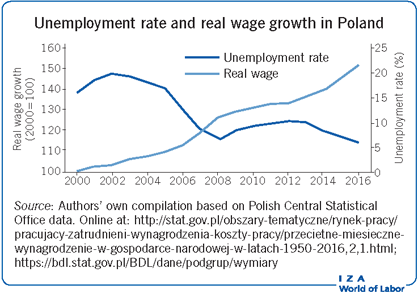Elevator pitch
In the early 2000s, Poland’s unemployment rate reached 20%. That is now a distant memory, as employment has increased noticeably and the unemployment rate has dropped to 5%. However, most of the net job creation has consisted of temporary jobs. Labor market segmentation has become an issue and an important factor behind wage inequality. Labor force participation of older workers increased after reforms aimed at prolonging careers, but the recent reversal of the statutory retirement age leaves Poland vulnerable to the effects of population aging.

Key findings
Pros
The employment rate for those aged 15–64 increased significantly between 2000 and 2016, while the unemployment rate declined noticeably over the same period.
Long-term unemployment dropped by ten percentage points between 2003 and 2016.
In 2016, the labor force participation of older workers reached its highest level since 1990.
Real wages increased by 54% between 2000 and 2016.
Real wage growth was the highest at the bottom of the wage distribution, and earnings inequalities have not changed much since the early 2000s.
Cons
Temporary employment has more than doubled since 2000, and Poland now has the highest share of temporary employment in the EU.
Labor force participation of older workers remains low in comparison to most developed countries.
The reduction of the retirement age in 2017 exacerbates the decline in labor supply resulting from population aging.
The gender pay gap remains high, especially after adjusting for differences in personal characteristics.
The total compensation of employees as a percentage of GDP is one of the lowest in the EU.